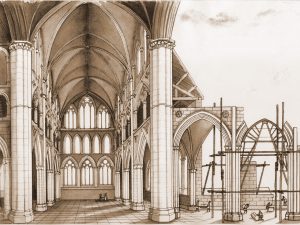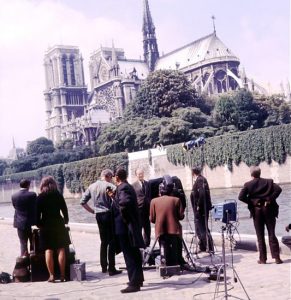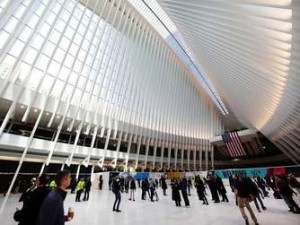IF IT AIN”T BROKE
Smart phones, iPads, and laptops are recent innovations, but their human interface is a Victorian technology that is almost 150 years-old. The QWERTY keyboard appeared first in an 1868 typewriter patent granted to Christopher Sholes, Carlos Glidden and Samuel Soule. The patent was acquired by E. Remington and Sons, a firearms and sewing machine manufacturer, and 5 years later, the so-called Sholes & Glidden, also known as the Remington 1, appeared. The machine was not perfect—it typed exclusively in caps, and the typist worked “blind,” that is, she could not see what she was typing since the keys struck the underside of the platen).

 According to a
According to a  There is a long tradition of architectural research in structures—one thinks of Nervi, Candela, Torroja, and Frei Otto, the pioneers of concrete like Perret, and much earlier the Byzantine and Gothic builders. Architects have sometimes experimented successfully with new building techniques and materials (Rudolph invented striated concrete blocks; Foster was the first to use structural glass fins). But research into how people use buildings is rare. The profession has always recognized the value of so-called post-occupancy evaluation, and the need for knowledge based on how people actually behave in and use buildings. The problem has been that this kind of research is extremely complicated,
There is a long tradition of architectural research in structures—one thinks of Nervi, Candela, Torroja, and Frei Otto, the pioneers of concrete like Perret, and much earlier the Byzantine and Gothic builders. Architects have sometimes experimented successfully with new building techniques and materials (Rudolph invented striated concrete blocks; Foster was the first to use structural glass fins). But research into how people use buildings is rare. The profession has always recognized the value of so-called post-occupancy evaluation, and the need for knowledge based on how people actually behave in and use buildings. The problem has been that this kind of research is extremely complicated, I’ve been watching Civilisation, the 1969 BBC television series, on YouTube. It’s a refreshing experience, and a reminder of how much the documentary film form has been influenced—I almost wrote infected—by Ken Burns. Instead of a revolving door of talking “expert” heads Civilisation makes do with a single presenter. There are no voice-overs pushing a narrative along, no actors dramatizing, no staged sequences, instead we have the wise (and rather dapper) Kenneth Clark to guide us. The 13-part series is subtitled “A Personal View,” and that is one of its strengths. Clark, an art historian,
I’ve been watching Civilisation, the 1969 BBC television series, on YouTube. It’s a refreshing experience, and a reminder of how much the documentary film form has been influenced—I almost wrote infected—by Ken Burns. Instead of a revolving door of talking “expert” heads Civilisation makes do with a single presenter. There are no voice-overs pushing a narrative along, no actors dramatizing, no staged sequences, instead we have the wise (and rather dapper) Kenneth Clark to guide us. The 13-part series is subtitled “A Personal View,” and that is one of its strengths. Clark, an art historian, Writing a
Writing a  These days, urban buildings are playing just one penny-whistle tune: glass, glass, glass. It’s as if there were a material shortage and we had run out of everything else. I don’t miss exposed concrete, but what about limestone and brick, terra cotta and granite? But no, architecture has been reduced to one material—even spandrels and soffits are glass. What explains this phenomenon? Well, of course it’s cheap. The engineer figures out the structure, and the architect wraps it in a glass skin. And the helpful glass manufacturers work out the details for you. It’s also easier to design. No more worrying about junctions between materials,
These days, urban buildings are playing just one penny-whistle tune: glass, glass, glass. It’s as if there were a material shortage and we had run out of everything else. I don’t miss exposed concrete, but what about limestone and brick, terra cotta and granite? But no, architecture has been reduced to one material—even spandrels and soffits are glass. What explains this phenomenon? Well, of course it’s cheap. The engineer figures out the structure, and the architect wraps it in a glass skin. And the helpful glass manufacturers work out the details for you. It’s also easier to design. No more worrying about junctions between materials, I recently watched an interesting
I recently watched an interesting  The newly completed Oculus in Manhattan is not just misnamed (an oculus is a round opening, not a slit) it is misconceived. It is not a question of design, or execution, or cost, but rather of the entire concept. Does a daily commute really require this level of architectural rhetoric? Even if this were a substitute for Penn Station, it would be a dubious proposition. It made sense for our forbears to celebrate long distance train travel, when railroad terminals really were the “gateways to the city.” Today, that is no longer the case. Even air travel has become a mundane,
The newly completed Oculus in Manhattan is not just misnamed (an oculus is a round opening, not a slit) it is misconceived. It is not a question of design, or execution, or cost, but rather of the entire concept. Does a daily commute really require this level of architectural rhetoric? Even if this were a substitute for Penn Station, it would be a dubious proposition. It made sense for our forbears to celebrate long distance train travel, when railroad terminals really were the “gateways to the city.” Today, that is no longer the case. Even air travel has become a mundane,